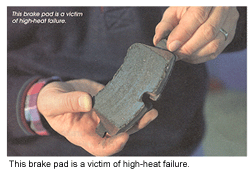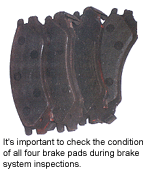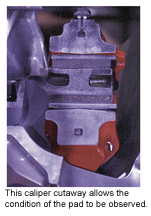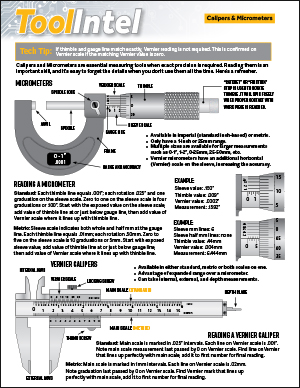Read any good brake pads lately? Don’t make the mistake of replacing brake pads without reading the old pads to spot potential caliper problems that could cause brake problems down the road and a possible comeback. Here are six conditions to watch out for:

UNEVEN PAD WEAR. A sure sign of caliper trouble. If the inner or outer pad shows significantly more wear than its companion, it tells you a floating caliper is sticking on its bushings or mount, or a caliper piston is sticking causing one of the pads to drag. Inspect the caliper mounts and bushings for rust and corrosion, and replace the caliper mounting hardware if it is in less-than-perfect condition. Also, be sure to lubricate the caliper mounts and bushings with high-temperature brake lubricant so the caliper can center itself over the rotor.
TAPER WEAR ON PADS. If the pads show more wear on one end than the other, or on the top or bottom edge, the caliper may be cocked or loose, the old pads may have been incorrectly installed, or the suspension may have a bent spindle causing misalignment between the rotor and pads. Check the alignment of the caliper. If the pads are not parallel to the rotor, the caliper mount is bent and must be replaced. If the pads are not perpendicular to the spindle, the mount or spindle may be bent.
If taper wear is noticed on a rear inner pad and the rear calipers have self-adjusting pistons, the pin that prevents the piston from rotating may not be lined up correctly with the hole or notch in the back of the pad.
PREMATURELY WORN PADS. Rapid pad wear usually indicates too much heat due to hard braking and use. Rapid wear can also occur if the pads are dragging because a caliper is hanging up or sticking, or the friction material is not up to the job (a common problem with cheap non-asbestos organic pads).
Brake wear is proportional to heat. The hotter the brakes, the faster they wear. Aggressive driving raises brake temperatures, as does everyday driving in heavy stop-and-go traffic (especially in larger vehicles such as full-size SUVs where the brakes have to stop a lot of weight). If somebody installed a set of cheap, no-name pads on the vehicle, the friction material may not have what it takes to withstand the heat. Upgrading to a premium-grade pad (ceramic or semi-metallic) may be necessary to solve this kind of premature wear problem.
The brakes can also run hotter than normal if the rotors have been replaced with ones that don’t have the same cooling fin configuration as the original, normal air flow to the rotors is blocked by an aftermarket air dam in front of the vehicle, or the vehicle has custom wheels, wheel covers or dust shields that don’t allow adequate air flow to the brakes. The rotors need lots of air flow to manage the heat, so make sure cooling is not a problem. Upgrades here include installing slotted and vented replacement rotors to dissipate the heat more quickly.
BADLY CORRODED PADS. Corrosion is an environmental issue and may occur when the brakes are exposed to excessive moisture and/or road salt. Semi-metallic friction materials can sometimes rust and stick to the rotors, but rust is usually more of a problem on the steel backing plates that support the friction material, or steel shims behind the pads. Rust may cause the pads to bind or wear unevenly or, in extreme cases, it may cause the friction material to separate from the backing plate.
Moisture can’t be avoided, so one way to minimize corrosion is to install pads that have some type of anti-corrosion treatment (paint or plating) on the steel backing plates, and use either integral shims or stainless steel shims that resist corrosion.
What about using a different friction material? Low metallic, non-asbestos organic (NAO) and ceramic friction materials are less vulnerable to rusting than semi-metallic friction materials, but may not be the best choice for high-heat, hard-use applications.
WET PADS. This would tell you the pads have been contaminated with brake fluid. The most likely cause is a leaky caliper piston seal, so the caliper will have to be replaced or rebuilt. If the vehicle has a lot of miles on it, chances are the caliper on the opposite side may soon be leaking, too, even if the pads on the other side are still dry. Recommend replacing both calipers now to reduce the risk of problems down the road and prevent a comeback.
GREASY PADS. The cause here is probably grease leaking from a wheel bearing hub seal or an outer CV joint boot. Don’t install new pads until the leak has been identified and fixed (replace the leaky seal, boot or hub assembly if wheel bearings are the sealed variety). Also, clean the rotors to remove all traces of grease. Grease-contaminated linings can cause a brake pull or jerky braking.
 READING CALIPERS
READING CALIPERS
Calipers can also be read, just like brake pads – only the clues may not be as obvious. Any caliper that’s leaking or sticking obviously needs to be rebuilt or replaced. But what if the calipers still look like new and the pads show no abnormal wear or contamination? What then? Should you recommend new or reman calipers, or just leave them alone when relining the brakes? Caliper piston seals don’t last forever, and once they start to leak it’s the end of the road for the caliper and the pads. Fluid leaks are dangerous because they can lead to a loss of hydraulic pressure in the brake circuit that may cause the brakes to fail. Brake fluid leaking from a caliper can also contaminate the brake linings and cause them to grab or pull. Caliper piston seals also lose some of their elasticity as they age. Square cut seals help pull the piston and pads back from the rotor when the brakes are released. Consequently, old, hard seals may cause the piston to stick and/or the pads to drag.
If this is the first brake job on a vehicle with relatively low miles (less than 40,000 miles) and the original calipers show no obvious problems, it’s probably safe to reuse them. Just make sure you clean and lubricate the mounts and bushings so the calipers will move freely.
On the other hand, if the vehicle has more than 40,000 or 50,000 miles on the original calipers, you should recommend replacing the calipers to minimize the risk of caliper problems until the next brake job. After all, it might be another 40,000 or 50,000 miles until the vehicle needs pads again, depending on how it’s driven. Highway miles are much easier on the brakes than city stop-and-go miles. So the question is, will the original calipers last until the next pad replacement?
REBUILD OR REPLACE?
Attempting to rebuild old calipers is often a waste of time. In many instances, the calipers are so badly corroded or worn they can’t be rebuilt – or they leak when they are put back on the vehicle. Disassembling a caliper to replace the piston seal and dust boot is a messy job, and may be difficult or impossible if the piston is stuck in place. Steel pistons often can’t be reused because they’re too badly rusted, and scratches or pits in the caliper bore may cause the caliper to leak even after a new piston and seal are installed. That’s why new or remanufactured calipers are usually preferred.
 As a rule, both calipers should be replaced at the same time unless the calipers have low miles and a caliper problem is not due to corrosion or age (such as a crack or other defect).
As a rule, both calipers should be replaced at the same time unless the calipers have low miles and a caliper problem is not due to corrosion or age (such as a crack or other defect).
Replacing the hardware is important, too, because old, corroded hardware can cause braking problems. We’ve heard of shims that have worked loose and caused a rotor to fail by cutting through the rotor hat! If you forget to install an anti-rattle clip or install one that doesn’t fit properly, the newly installed pads may be noisy.
Loaded calipers have become a popular option because they reduce these risks by including everything that needs to be replaced (caliper, hardware and pads) in one box. This simplifies installation, saves time and reduces the risk of comebacks. Loaded calipers cost more than bare calipers, and some customers may complain about the higher cost. If they do, you can offer them the option of installing reman calipers. Either way, the goal should be to restore the brakes to like-new condition.
MATCH THE FRICTION MATERIAL
If you opt for loaded calipers, the type of friction material that’s included should be the same as, or better than, the original. If a vehicle was originally equipped with ceramic pads, the loaded caliper should have ceramic pads that are equivalent to the original pads. The same goes for semi-metallic pads (replace same with same).
To avoid a mismatch of friction side-to-side, both calipers should be replaced at the same time if you are installing loaded calipers. If only one caliper is being replaced, be sure to use the same friction pads on both sides.
Other items that may need attention include the brake hoses and lines. Replace hoses if they are age-cracked, leaking or show any visible damage. Steel lines should be replaced if they are badly rusted, crimped or leaking.
Caliper slides and bushings should be lubricated with a high-temperature brake grease, and related brake components such as hoses, lines, rear-wheel cylinders and the master cylinder should all be inspected to make sure they are in good working condition and are leak-free.
After the calipers have been installed, the brake system should be flushed and refilled with clean, fresh fluid that meets OEM requirements for the application (DOT 3 or 4 fluid). The brake fluid specification can usually be found on the fluid reservoir, filler cap or in the owner’s manual. Happy reading!









 READING CALIPERS
READING CALIPERS As a rule, both calipers should be replaced at the same time unless the calipers have low miles and a caliper problem is not due to corrosion or age (such as a crack or other defect).
As a rule, both calipers should be replaced at the same time unless the calipers have low miles and a caliper problem is not due to corrosion or age (such as a crack or other defect). 



